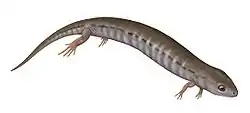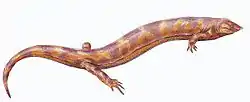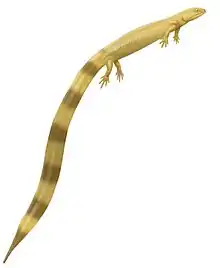Stegotretus
Stegotretus is an extinct genus of lepospondyl microsaur referred to the Pantylidae. It is known from the Carboniferous–Permian boundary Cutler Formation exposures of New Mexico.[1]
| Stegotretus Temporal range: Late Carboniferous or Early Permian | |
|---|---|
| Scientific classification | |
| Kingdom: | Animalia |
| Phylum: | Chordata |
| Subclass: | †Lepospondyli |
| Order: | †"Microsauria" |
| Family: | †Gymnarthridae |
| Genus: | †Stegotretus Berman, Eberth & Brinkman, 1988 |
| Type species | |
| †Stegotretus agyrus Berman, Eberth & Brinkman, 1988 | |
History of study
Material now referred to Stegotretus was first described (in brief) by Eberth & Berman (1983).[2] It was formally named by Berman et al. (1988).[1] The genus name comes from the Greek stegos ('roof') and tretos ('perforated') to refer to a large fenestra found on the palatine bone. The species name, S. agyrus, is said to be derived from Greek agyrus ('gathering' / 'crowd') in reference to the concentration of all known specimens in a small area.[1] The proper word in ancient Greek for 'gathering' / 'crowd' is however agora (ἀγορά), with the variant agyris (ἄγυρις) in the Aeolic dialect.[3] The holotype and referred materials are currently reposited in the Carnegie Museum of Natural History. A large number of partial to complete skulls and associated postcrania are known for this taxon.
Anatomy
Despite the large number of specimens of Stegotretus, many are poorly preserved or distorted. Stegotretus is diagnosed by the presence of only two premaxillary teeth and by a large circular fenestra on the palatine. A contact between the maxilla and the quadratojugal and the absence of an entepicondylar foramen on the humerus separate it from the purportedly closely related Pantylus.
Relationships
Stegotretus was classified as a pantylid by Berman et al. (1988). This has been validated by phylogenetic analyses that include the taxon,[4][5][6] although it is sometimes recovered as being more closely related to Sparodus than to Pantylus when all three taxa are sampled.[7] Below is the result of the analysis by Huttenlocker et al. (2013):
| Microsauria |
| |||||||||||||||||||||||||||||||||||||||||||||||||||||||||||||||||||||||||||||||||||||||||||||||||||||||||||||||||||||||||||
References
- Berman, D.S.; Eberth, D.A.; Brinkman, D.B. (1988). "Stegotretus agyrus, a new genus and species of microsaur (amphibian) from the Permo-Pennsylvanian of New Mexico". Annals of Carnegie Museum. 57: 293–323.
- Eberth, David A.; Berman, David S (1983). "Sedimentology and paleontology of Lower Permian fluvial redbeds of north-central New Mexico - preliminary report" (PDF). New Mexico Geology. 5: 21–25.
- Liddell, H.G. & Scott, R. (1940). A Greek-English Lexicon. Revised and augmented throughout by Sir Henry Stuart Jones with the assistance of Roderick McKenzie.Oxford: Clarendon Press.
- Huttenlocker, Adam K.; Pardo, Jason D.; Small, Bryan J.; Anderson, Jason S. (2013). "Cranial morphology of recumbirostrans (Lepospondyli) from the Permian of Kansas and Nebraska, and early morphological evolution inferred by micro-computed tomography". Journal of Vertebrate Paleontology. 33 (3): 540–552. doi:10.1080/02724634.2013.728998. ISSN 0272-4634.
- Anderson, Jason S. (2001-03-01). "The Phylogenetic Trunk: Maximal Inclusion of Taxa with Missing Data in an Analysis of the Lepospondyli (Vertebrata, Tetrapoda)". Systematic Biology. 50 (2): 170–193. doi:10.1080/10635150151125833. ISSN 1076-836X.
- Marjanović, David; Laurin, Michel (2019-01-04). "Phylogeny of Paleozoic limbed vertebrates reassessed through revision and expansion of the largest published relevant data matrix". PeerJ. 6: e5565. doi:10.7717/peerj.5565. ISSN 2167-8359. PMC 6322490. PMID 30631641.
- Ruta, Marcello; Jeffery, Jonathan E.; Coates, Michael I. (2003-12-07). "A supertree of early tetrapods". Proceedings of the Royal Society of London. Series B: Biological Sciences. 270 (1532): 2507–2516. doi:10.1098/rspb.2003.2524. ISSN 1471-2954. PMC 1691537. PMID 14667343.



